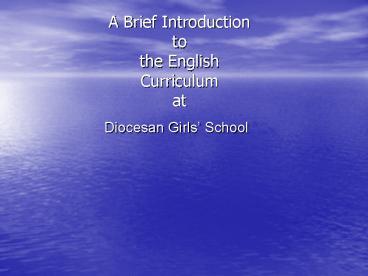A Brief Introduction to the English Curriculum at - PowerPoint PPT Presentation
1 / 18
Title:
A Brief Introduction to the English Curriculum at
Description:
and Romeo and Juliet(Penguin Readers). Other strategies to enhance language acquisition ... English Club activities, Inter-House English Drama. ... – PowerPoint PPT presentation
Number of Views:335
Avg rating:3.0/5.0
Title: A Brief Introduction to the English Curriculum at
1
A Brief Introduction to the EnglishCurriculuma
t
- Diocesan Girls School
2
Aims of the DGS English CurriculumTo empower
students in the use of English to an exceptional
standard such that they
- think analytically, critically and independently
- become acquainted with the culture and
conventions of the language behaviour of other
countries - acquire lifelong education in institutions both
locally and abroad - develop an aesthetic appreciation for language
- and a love of reading
- are equipped for the world as a global village of
the twenty-first century.
3
Areas of Exposure
4
Junior Curriculum StreamingRationale
- To tailor the pace and level of teaching to the
the standard of each student in the class. - To provide a non-threatening environment for
greater interaction, both with the teacher and
with their peers. - To allow greater flexibility of materials and
style of teaching and learning. - Streaming has proven very effective in achieving
the desired learning outcome.
5
English Classes at DGS for 2008-2009
6
Implementation of Streaming
- Screening Test conducted in Form 1 in late April.
- The Screening Test comprises 4 different papers
they include dictation, comprehension, usage and
composition. - Class size for each set ranges from 35-25
students per class. - As they move up the Form, there is mobility
between sets based on performance in the subject
as well as the teachers recommendation.
7
Literature as a key component toLanguage
appreciation
- S1 to S3 students have at least one lesson of
English Literature in the curriculum. - This helps to supplement the Language Arts
- curriculum in the junior curriculum as well as
fit in with the proposed NSS curriculum. - By the end of Secondary 3 they will have done
each of the three genres of Prose, Poetry and
Drama. - They will have a good appreciation of Literature,
and have the option of studying it at Form 4 and
beyond.
8
Texts Covered in the Literature Curriculum
- Secondary 1
- Enchanted Island, an introduction to Shakespeare.
- Enjoying More Poetry.
- Bridge to Terabithia.
9
Secondary 2
- Enchanted Island.
- Enjoying More Poetry.
- Snapshots a collection of short stories.
10
Secondary 3
- Working with Short Stories.
- Focus on Drama.
- St. Joan by George Bernard Shaw.
- Shakespeares Merchant of Venice
- and Romeo and Juliet(Penguin Readers).
11
Other strategies to enhance language acquisition
- Use of overseas textbooks as well as resources
developed in-house. - Set Texts for different Forms e.g. Diary of Ann
Frank, Walk Two Moons, Animal Farm, Fahrenheit
451, To Kill a Mockingbird etc. - - Participation in speech festival, public
speaking, debates, Model United Nations, both in
Hong Kong and at Cornell University, US. - English Club activities, Inter-House English
Drama. - Publications including the School Magazine, the
DGS Times, 5A Magazine. - Extensive Reading Scheme.
- Exchange Trips with schools in Melbourne and
Singapore. - Writes of Spring writing competition.
12
Pyramid showing the Hierachical Structure of
English Department A Bottom-Up Approach
13
Cycle of Implementing Curriculum Changes
Assessment
14
Challenges Ahead
- The need to adjust to the New Senior Secondary
Syllabus. - The need to handle the logistics of moving to the
new hotel school. - Timetabling the need to run the current AS
Syllabus and the NSS concurrently.
15
The Most Important Criterion for a successful
English Curriculum is.
Its People.
16
Teachers in Action
17
Students in Action.
18
The End
- Thank you
- Powerpoint prepared by Mr. Joe Oddie
- Head of English
- DGS
- joeoddie_at_hotmail.com































